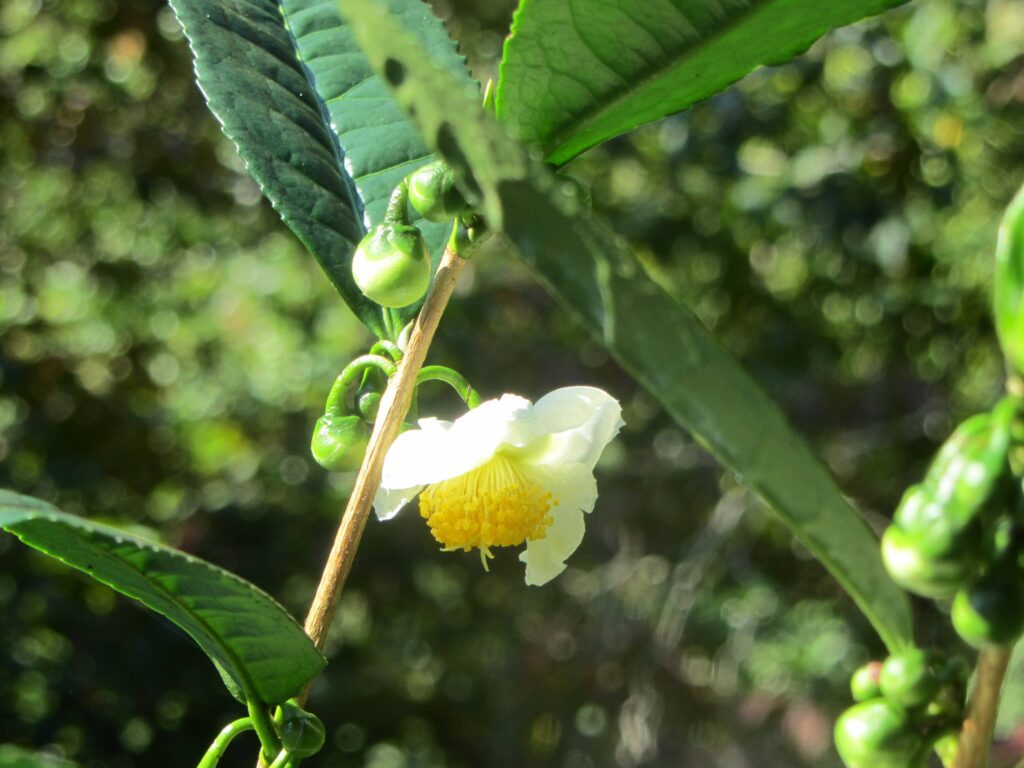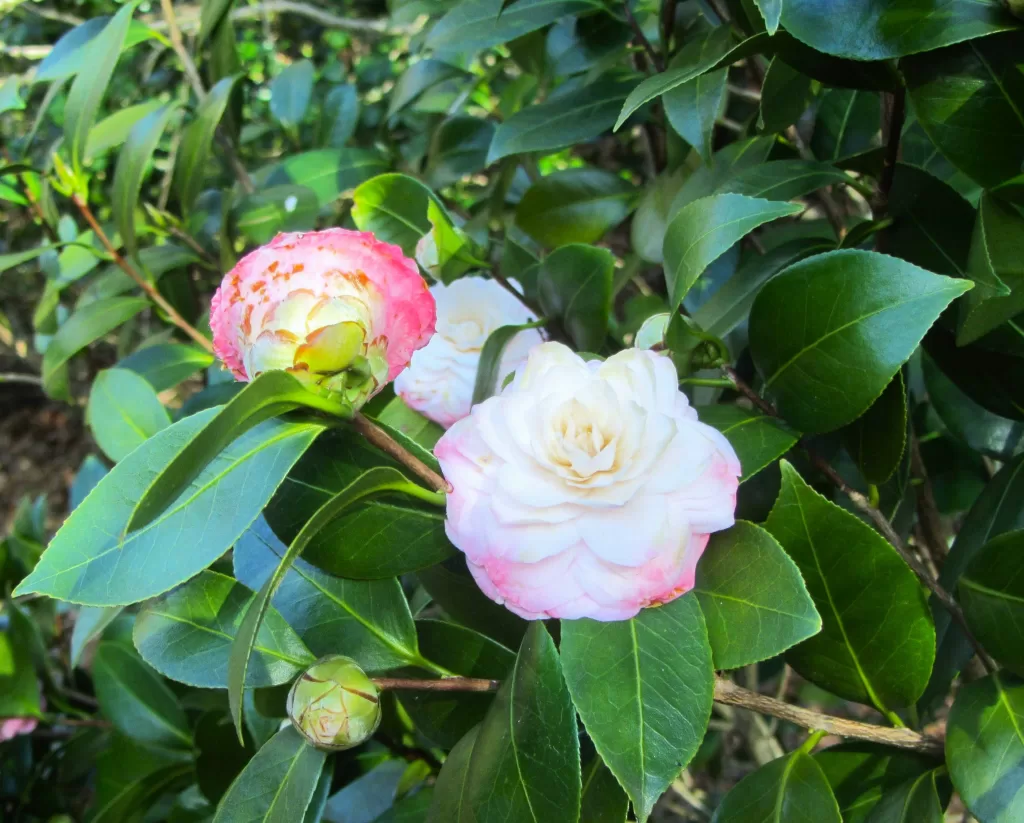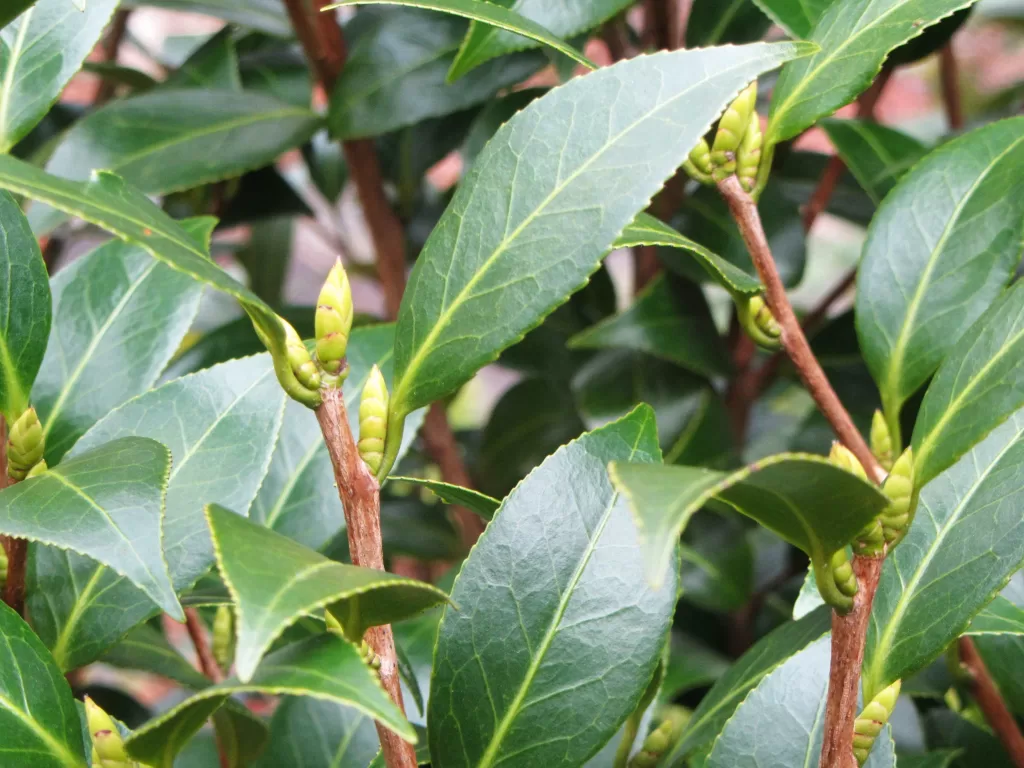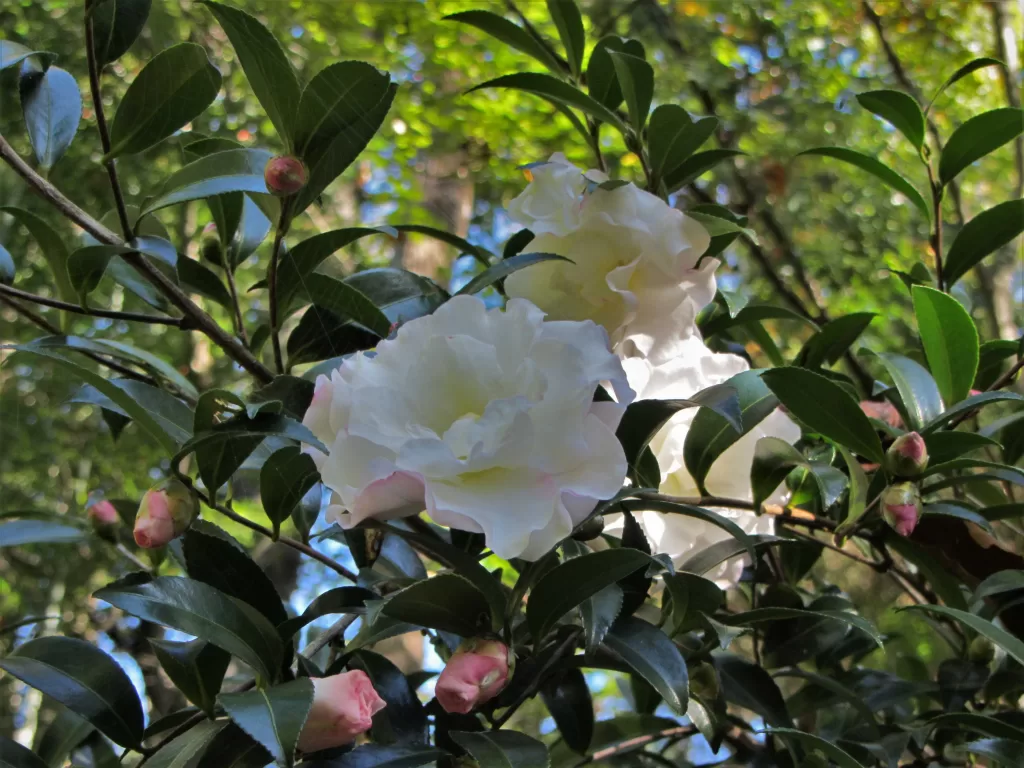A Tea Story: Past and Future
The Long Story of Tea in America
Have you ever wondered where your tea comes from? Tea is one of those everyday things that we can always find at the grocery or convenience store. You may remember that tea was imported to Boston in the Colonial era. Maybe you also remember the story of how colonists, dressed as Native Americans, dumped the British East India Company’s cargo of tea into the Boston Harbor in December 1773 to protest unfairly high British taxes on their tea. This very expensive vandalism and was an important steppingstone to hostilities between colonists and the British government, which eventually led to the war for American independence. It became fashionable in that era to boycott British tea for a while and make colonial herbal teas as a patriotic substitute.
Native American Tea
By 1774 colonists, accustomed to drinking tea, relied on a variety of herbal teas, known as ‘tisanes,’ as a substitute for the imported tea heavily taxed by the British government. One surprising substitute was an infusion made from the roasted and dried leaves of native yaupon holly that they had learned to make from Native Americans. Indigenous tribes living along the southern Atlantic and Gulf Coasts had long prepared and brewed yaupon leaves into a hot beverage known as cassina or black drink, which they drank daily as we drink coffee or tea. They also prepared cassina to trade with distant tribes who couldn’t grow their own yaupon, and later traded it with colonists.
Colonists in the southern colonies produced and exported this ‘Indian’ or ‘Carolina’ tea to Europe until the 1780s. But in 1789, English botanist William Aiton, Director of Kew Royal Botanical Gardens and a personal friend of King George, officially changed the name of this native holly from Ilex cassine to Ilex vomitoria. This dampened enthusiasm for the less expensive, American beverage. Yaupon tea is easy to make at home from the native yaupon holly shrub that grows throughout our area. The scientific name is an interesting story of misnaming all to itself, and it isn’t true that drinking cassina, or yaupon tea, will cause one to vomit unless one drinks a huge quantity of very strongly brewed tea.
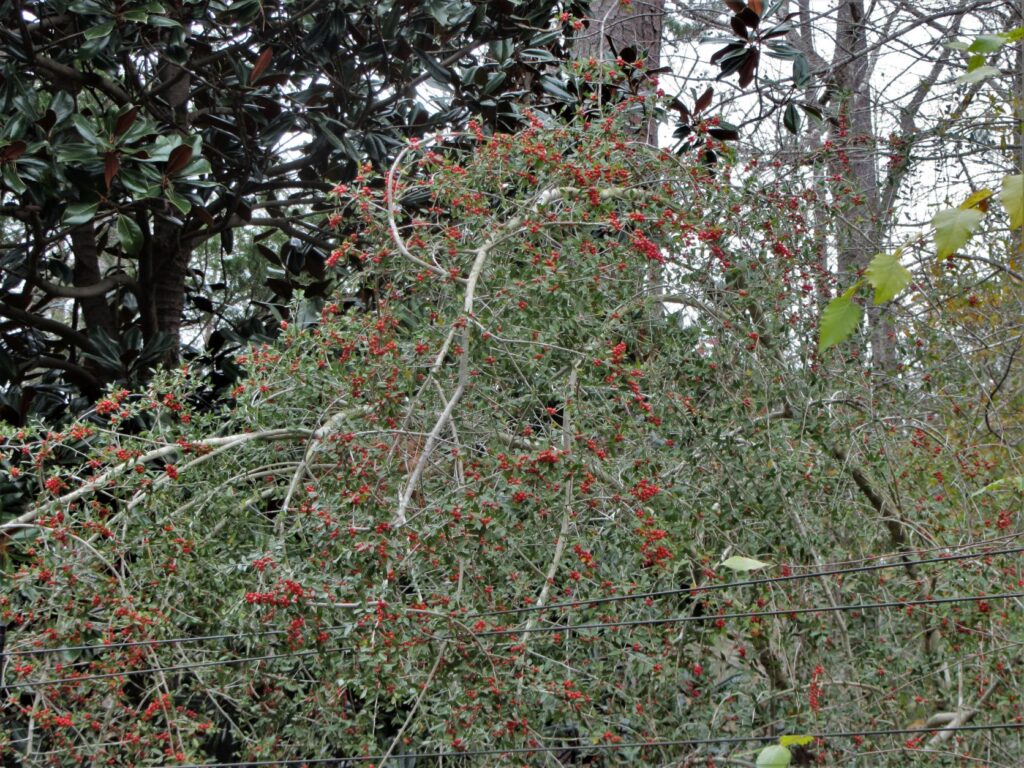
Yaupon holly, I. vomitoria ‘Pendula’ (F) grows at the Williamsburg Botanical Garden and Freedom Park Arboretum. A male plant, which never produces berries, grows nearby. There are many other cultivars and forms of yaupon, including dwarf shrubs like ‘Nana.’ Tea may be made from the leaves of all yaupon holly plants.
But where did the British East India Company buy their cargo of tea? And why was it such a big deal?
Five Thousand Years of Tea Culture
Tea leaves grow on a tree native to China. Tea has been cultivated in temperate Asian countries since very ancient times, and in China, tea can be traced back through written records to the third millennium BCE. We now know that there is also a variety of tea native to India, but the British botanists wanting to buy (or steal) tea plants from China, and discover the secrets of growing and processing tea, didn’t know that until much later. The British eventually learned how to grow tea in their newly conquered colonies in India and created one of the largest tea exporting businesses in the world.
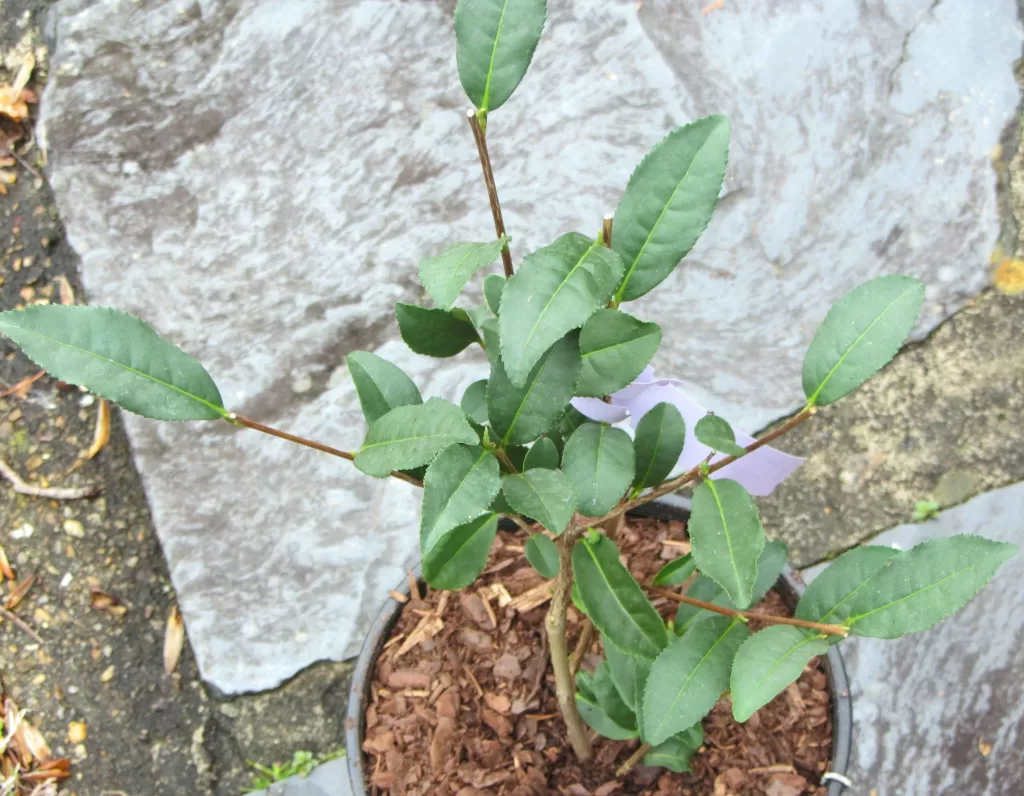
Camellia sinensis ‘Brew-Tea-Ful’ will remain a dwarf, and is intended to grow in a container for home tea production.
Dutch traders brought the first tea to Europe in the early 17th century, and it was imported in England around 1650. Dutch trading ships also brought the first tea to New York around 1650, so tea was introduced to colonists around the same time the British first tasted it. At first, tea was enjoyed only by the aristocrats due to its high cost. It was stored in locked tea chests in some households. Tea became available to a wider slice of the population as trade with China expanded and the price of tea dropped. Tea was the first beverage that is both calming and stimulating. It can also be medicinal.
Tea culture and cultivation developed alongside meditative spiritual traditions in China, Japan, and India because it helped the meditator to remain awake and alert during their practice. It is still very important for Taoists and Buddhists, and those of related contemplative traditions around the world. It remained a well-guarded Asian secret for centuries, sometimes cultivated around temples. When exported to Europe, tea was a pleasant pick-me-up beverage for breakfast and late afternoon.
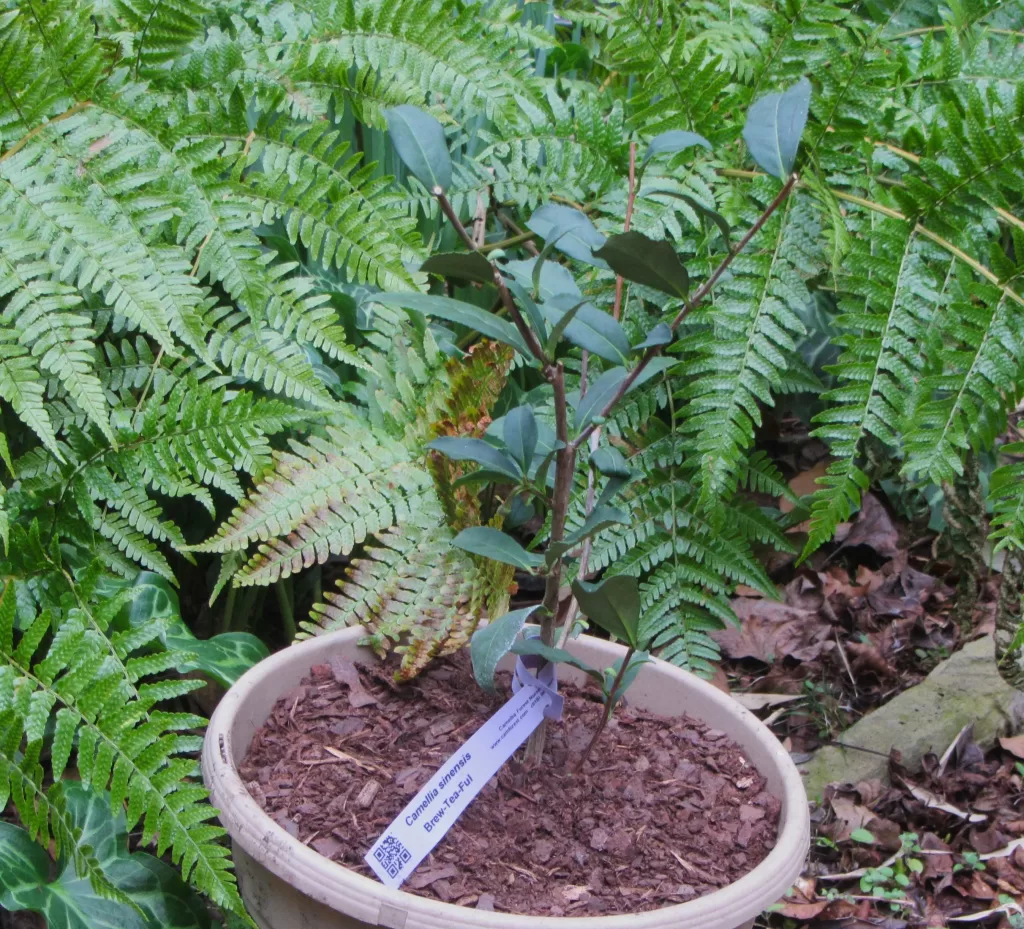
This clone of the trademarked dwarf tea shrub ‘Brew-Tea-Ful’ arrived in a two quart pot from the Camellia Forest Nursery last week. The nursery pruned this shrub to get it off to a good and productive start. It will yield a small amount of tea this year, and will grow on in this pot for the next several years. While tea plants will grow in full sun, I plan to keep this plant on a second story deck, out of reach of deer, in partial sun.
“It’s Just Business…”
Eventually, the tea trade became a huge business. With tea available only from China in those days, there was a trade imbalance that the British East India Company desperately wanted to resolve. They tried to help finance their purchases of tea by selling opium raised in India to the Chinese, beginning in the 18th century. By the mid-19th century, British tea purchases were financed by opium sales, but the Chinese government was of course angered that so many of their people had become addicted to opium. You may remember that Great Britain and China fought two ‘Opium Wars’ in the 19th century over the opium trade.
Espionage and Deception
Great Britain, and other European nations, were desperate to find a way to grow tea outside of China. Scottish botanist Robert Fortune mounted an expedition to China in the mid-1840s, after the end of the first Opium War, in search of tea plants. His success came in 1848, on his second expedition, when he disguised himself as a Chinese mandarin to trick the Chinese tea growers he visited to learn the secrets of tea production.
He bought and exported 20,000 tea plants to British territories in northwestern India to establish tea plantations. We have since learned that a variety of tea is native in this region, but European botanists didn’t know that at the time. Most of Fortune’s plants soon perished because they weren’t suited to the climate in this region of India, but successful tea plantations eventually were established at Assam and Darjeeling, making India is one of the largest producers of tea in the world today.
Botanists’ efforts to get tea plants from China persisted. At times, the Chinese were persuaded by European traders to sell tea seeds. Protecting their cash crop, as you might expect, they sold seeds of related species, but rarely of their prized tea plants. Now working for the US government, Fortune finally purchased 30,000 tea plants and seeds from the Chinese in the 1850’s to establish tea culture in the United States. And what grew from most of those Chinese seeds, you may wonder? Ornamental Camellias.
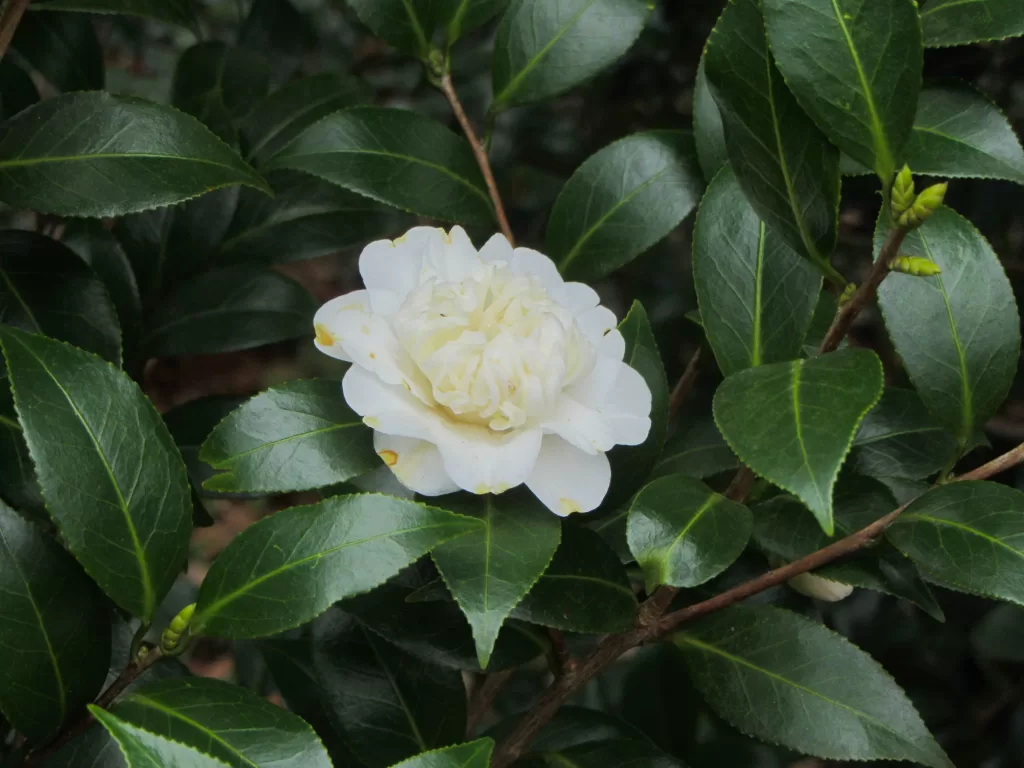
Camellia japonica ‘Victory White’ has leaves and a growth habit similar to a tea Camellia, but its leaves aren’t good for making tea.
The Asian Origin of Tea
Tea is made from the leaves of one species of Camellia, Camellia sinensis. ‘Sinensis’ refers to the shrub’s origins in China. C. sinensis var. sinensis is the variety that was grown at the time in China. It is hardier, and has smaller, more delicate leaves. It is pruned as a low shrub to maximize production and assist with plucking new growth for tea. Left unpruned, some cultivars can grow to around 12’ tall. The Indian variety, C sinensis var. assamica, was already growing in Assam, in northern India, near current Bhutan. It prefers a warmer, more humid climate. C. sinensis var. assamica grows into a small tree, to nearly 60’ tall, if not pruned to a smaller size for picking. Its leaves are larger and not as delicate.
If you like black breakfast tea, it may be produced from this larger assamica variety, which is still grown in India for the worldwide tea trade. All familiar types of tea can be produced from C. sinensis plants. Tea with familiar brand names like Twining, Tetley, Lipton, Bigelow, and Stash may be grown on small farms in China, Southeast Asia, India, Africa, or South America. More than 40 countries now produce tea commercially.
Try, Try and Try Again
Many attempts to grow tea in the southeastern United States, beginning in 1744 in Savannah, didn’t succeed. Several plantations in Georgia and South Carolina tried tea over the years, and a tea plantation planted in 1813 near Charleston, SC, on Wadmalaw Island proved successful. It produced tea largely for sales in the United States. Bigelow now owns this South Carolina ‘Tea Garden.’ Lipton’s has sponsored numerous research projects in its efforts to grow tea domestically on the West Coast and in the Southeast.
Tea plants grow well in all these areas, but tea production is very dependent on skilled, hands-on labor for plucking the leaves and for processing them into tea. A variety of problems plagued these early efforts at tea production. In some cases, the entrepreneur died before the shrubs became productive, and no heir continued the business. Hurricanes and other unexpected weather events have damaged tea plantings. In many cases, it never became practical and lucrative to sell the tea because of labor costs. There was no mechanical equipment suitable for picking or processing the tea leaves until recent decades.
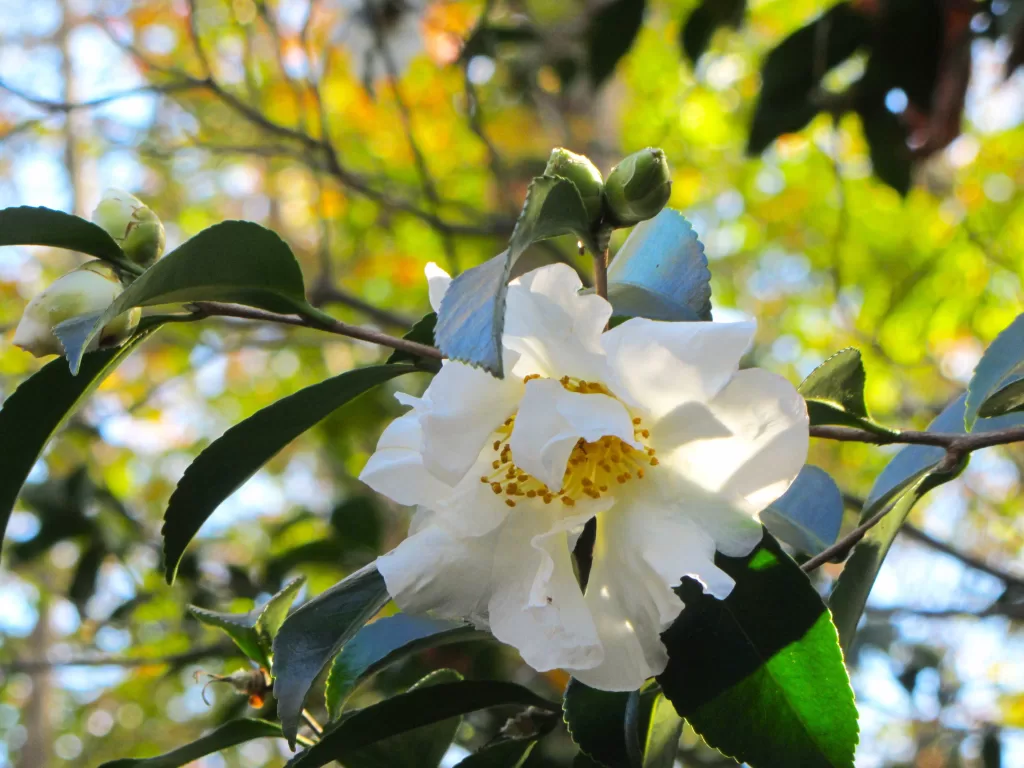
C. sasanqua ‘Autumn Rocket’ is not a tea Camellia, but it blooms at the same time with a larger, but similar flower.
Camellia Confusion
If you grow flowering Camellias, you may not have guessed that tea comes from a similar shrub. In those early days when the first Camellia seeds were exported to Europe, they were carefully grown in hothouses by skilled gardeners. It took a while to figure out that while beautiful, the leaves of those shrubs would never produce the delicious, aromatic tea produced from C. sinensis. Leaves from ornamental Camellias, like C. japonica and C. sasanqua, are not used for producing tea.
Seeds of several different Camellia species were sent to Europe, including C. oleifera, from which tea tree oil is made, and additional ornamental species. The Colonial Williamsburg Arboretum has a C. oleifera tree growing near the Griffin Hotel. Oil made from pressed Camellia seeds is another cash crop in Asia that has grown more popular around the world because the oil can be used in cooking, for healing, and it has uses in manufacturing. This species also has smaller, generally white flowers like C. sinensis. Oil can also be pressed from C. sinensis seeds, and from a few other species in smaller quantities.
A Better Business Opportunity
Europeans were so impressed by these new, winter blooming flowers that a huge market developed for cut Camellias in the florist trade. Flowering Camellias also became a huge business in many parts of the United States for both florists and the nurseries. Several cities established Camellia gardens, like the one at the Norfolk Botanical Gardens, for everyday people to enjoy Camellia shrubs blooming each year. Camellias are easy enough to propagate that growers could raise them in large quantities and sell them quickly to Camellia lovers.
The tea shrubs we have available in the United States today may originate from various regions of China, Korea, Vietnam, Japan, Taiwan, India, or from other southern Asian countries. American growers continue to select cultivars, propagate sports, and develop hybrids, particularly cold-hardy hybrids.
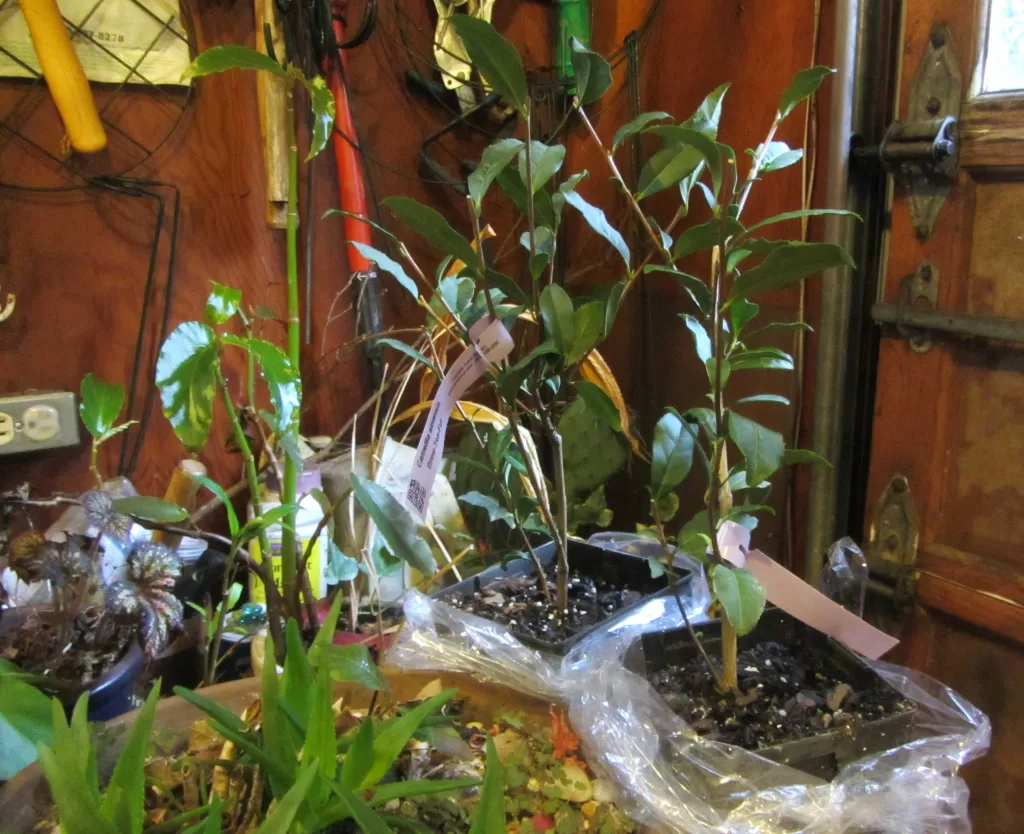
The new tea plants arrived during a cold spell, so they needed to stay in the garage for the first week or two to prevent their roots from freezing. They were kept in a greenhouse at the nursery. After a few days to adjust in milder weather, they will live outside year-round.
Growing Camellias in Coastal Virginia
Camellia shrubs grow well as understory shrubs or small trees, in partial shade, in Zones 7-9. Camellia japonica grows more reliably in colder regions and some species will grow as far north as Zone 5. Specialized cold-tolerant varieties will grow in even colder climates into Canada. Camellia sasanqua, which blooms from October through January in our area, prefers a warmer climate. The northern edge of its range is Zone 7.
Camellia sinensis, the tea tree, is more like C. sasanqua than it is like C. japonica. It can grow in full or partial sun. It prefers a warmer climate and blooms in the fall. But because there are different varieties of C. sinensis available now, it is possible to grow it in Zone 6, and perhaps further north with winter protection. There is a newly planted tea garden in Scotland experimenting with how to grow tea through a Scottish winter. Tea can also be grown in containers in a frost tunnel or slightly heated greenhouse where winters are too cold.
This means that we can grow our own tea in coastal Virginia just as easily as we grow our own tomatoes, figs, squash, and cherries. And Camellia is an easy shrub to grow given consistent moisture, well-drained acidic soil, and light shade during the summer. Camellia plants won’t survive in saturated soils. They are prone to ‘root rot’ disease when their roots can’t breathe. Good drainage is very important whether the plant grows in the ground or in a container. This is a great shrub to plant on a slope or in a raised bed.
While deer and voles may attack young plants, those that survive attacks in their early years will grow large enough to survive any later damage. Protect young tea plants from deer with a physical barrier like a fence or small wire cage. Protect the stem from voles by keeping mulch between 1″ and 2″ away from its bark. Planting tea Camellias on a raised bed or mound gives them further protection from voles and deer. Serious tea gardeners might even build a wire enclosure around a large raised bed of tea plants.
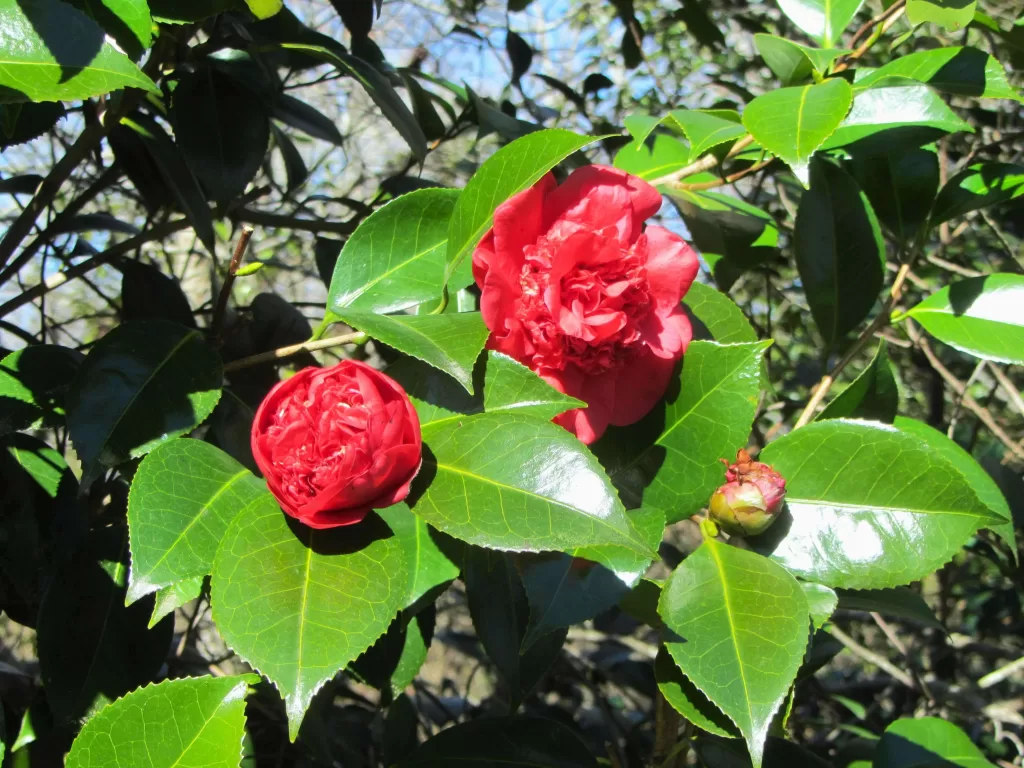
C. japonica ‘Kramer’s Supreme’ is one of the earliest spring Camellias to bloom. These leaves are too tough to process as tea.
Contemporary ‘Tea Gardens’ for Fun and Profit
‘Tea gardens’ may be found in many surprising places in the United States. Private gardeners, small businesses, and university researchers grow anywhere from a few shrubs to many acres of tea. Tea gardens have grown to be a popular destination for ‘agro-tourism’ in some areas just like vineyards with wineries, orchards, and berry farms. Improved selections and hybrids of C. sinensis allow gardeners and growers to select shrubs suited to their own micro-climate and needs.
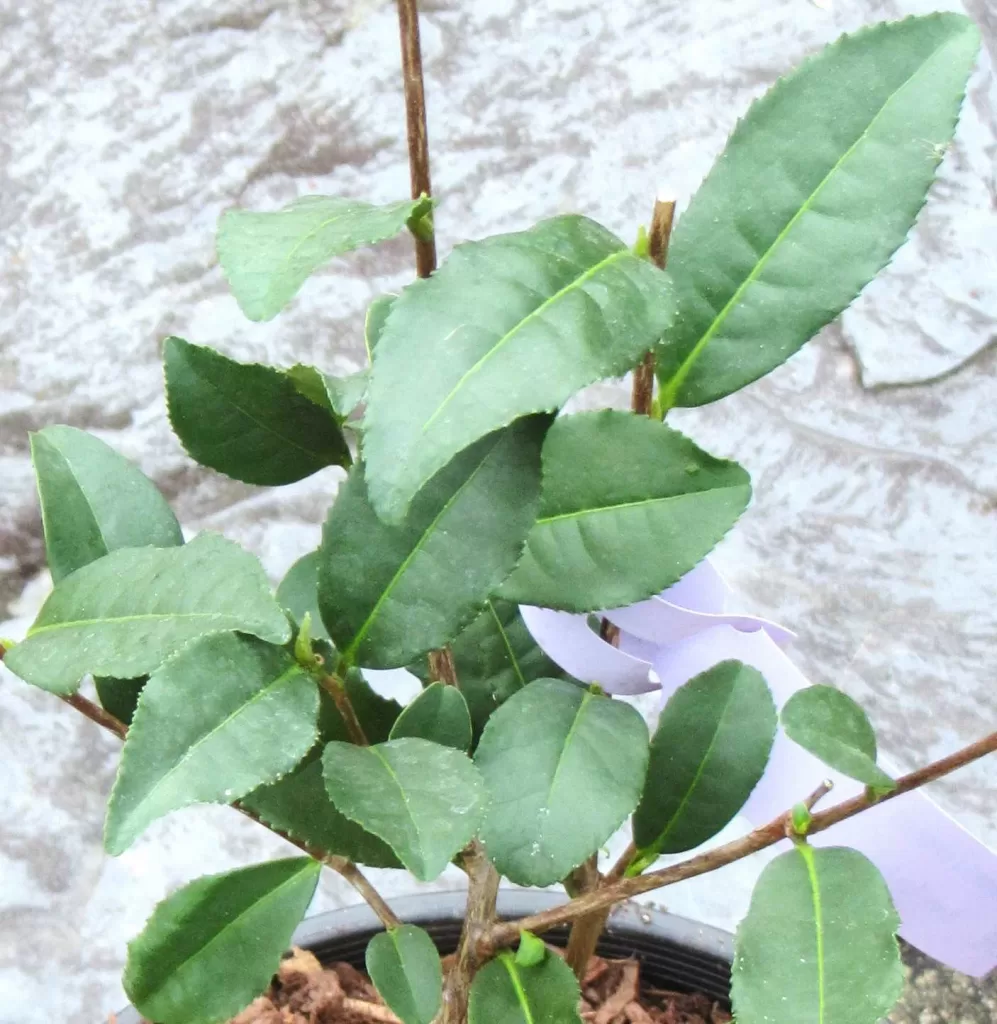
Mature C. sinensis leaves are still too tough to produce good tea. New, soft growth is plucked while the stem is pliable enough to easily break off in one’s hand. A new bud and one or two new, soft, leaves are harvested for tea. These woody branches are developed into a scaffolding to produce frequent flushes of new growth for harvest.
How to Produce Your Own Tea at Home
Any interested gardener can grow tea for their own use. One can grow a single shrub in a container on a deck or patio. New growth on the shrub, a bud and one or two leaves, may be harvested by hand by pinching the stem. These tender leaves and buds can be processed in a home kitchen with no more equipment than is needed to bake a loaf of bread. A person with any ability level, or with physical disabilities that make other gardening projects difficult, can still manage this simple process. From shrub to cup, the process of making tea is simple and requires no more than a day or two.
Many different ‘types’ of tea may be made from a single shrub. Whether the finished tea is white, green, black, or any of many other strengths and colors is determined by which leaves are picked and how they are treated after picking. Briefly, the newly picked leaves are set out to ‘wilt’ or ‘wither’ for several hours in either sun or shade. Then they are first heated and then are ‘rolled’ and bruised to break down cell walls in the leaf. Next, the leaves are allowed to oxidize, or darken, to the desired stage, before they are dried in an oven or microwave. Once dried, the tea is ready to brew or to store.
The ambient temperature and amount of sunlight, shade, and humidity at each stage govern the chemical processes going on in the leaf, and that determines the types of flavors, aromas, and colors that develop in the tea leaves. While white and green tea are the least processed, black tea and oolong tea take the most time. White tea is the simplest tea to produce since it requires only an initial long withering, followed by drying. In addition to the tea leaves, home tea growers may add flowers, herbs, and citrus oils or peels to their blends to produce an endless variety of teas.
Learn From the Experience of Others
An excellent and beautiful guide to growing, harvesting, and preparing tea is Grow Your Own Tea by Christine Parks and Susan Walcott. Christine Parks is the co-owner, along with her husband, David, of Camellia Forest Nursery and Tea Gardens in Chapel Hill, NC. Her friend, Susan Walcott, is on the faculty of the University of North Carolina, Greensboro. Together they have visited tea gardens around the United States and abroad to learn more about growing and preparing tea. They both grow and prepare their own tea and create teas for the Tea Garden at Camellia Forest Nursery. The Tea Garden at Camellia Forest offers regular tours and classes to teach tea lovers how to grow and prepare their own custom teas. Their well illustrated book helps a beginner navigate every step from planting their first tea shrubs to harvesting and processing the tea.
An Investment in the Future
It is possible to plant and enjoy a Camellia sinensis shrub and never harvest new growth to make tea. Camellia plants are very long-lived when they are grown in favorable conditions and may live more than 50 years. Like a tree, a Camellia shrub planted today is an investment in the future. It will bloom with small, white, usually single flowers each autumn. The flowers may be fragrant, although they are smaller than those of ornamental Camellias.
Depending on whether a plant is grown from a cutting or a seed, and how it is cared for, it may be ready to harvest within its first 3 to 5 years of life. The shrub will produce new growth that can be plucked for tea, from spring through fall, each year after. Harvesting leaves stimulates new growth. A mature shrub can have leaves harvested regularly during the growing season, with each new flush of growth appearing every few weeks. You might harvest a few sprigs of leaves from a large shrub every day from April or May through September.
A Contemporary Victory Garden
Growing tea at home is a special and delicious sort of ‘Victory Garden.’ Your ‘victory’ is in living sustainably, using fewer resources, and making a personal contribution to mitigating climate change. Consider how functional an evergreen, flowering tree like Camellia can be in the landscape. Evergreen trees and shrubs filter the air, sequester carbon, and produce oxygen every day of the year while supporting pollinators when they bloom, and providing habitat for birds and other animals year-round. They create cooling shade and help to manage run-off after a rain, returning groundwater to the atmosphere. This further cools the air in your yard. Large Camellias contribute to a healthy, peaceful microclimate around your home.
Growing and processing your own tea, instead of buying commercial tea grown abroad, further reduces your carbon footprint and reduces the packaging waste you throw away. It is a win-win for your family and for the environment as you produce custom teas, suited to your taste, at no cost beyond planting the Camellia tree. The same can be said for tea made from yaupon holly you grow in your yard, as well as herbal teas you make at home from mint, bee balm, lemon verbena, and other herbs and flowers.
In the mid- to late 19th century, the US government provided farmers in the American Southeast with tea seeds and plants to encourage those who had land to grow their own tea, and to seed small tea producing businesses. As with the earlier attempts, this effort largely failed. It was easier and cheaper to buy imported tea because few Americans had the knowledge to produce high quality tea. Perhaps the time has finally come for interested gardeners to discover the simplicity and joys of growing our own tea, just as we take pleasure in growing summer vegetables, herbs, and cut flowers.
A little knowledge and imagination is all it takes to begin.
All photos by E. L. McCoy
For More Information:
Ackerman, William L. Beyond the Camellia Belt: Breeding, Propagating, and Growing Cold-Hardy Camellias. Ball Publishing. 2007.
Arthur, Brie. “Heritage Camellias, A Growing History.” Triangle Gardener. November 2023.
Doubrava, Nancy, Janet McLeod Scott, James H. Blake, Clyde S. Gorsuch, revised by Joey Williamson. “Camellia Diseases & Insect Pests” factsheet. Clemson Cooperative Extension Home and Garden Information Center. February 2021.
“History of Camellias.” American Camellia Society. November 2023.
Latta, Forrest S. and Brenda C. Litchfield. Camellia Garden Field Guide 3rd edition. CreateSpace Independent Publishing Platform. 2015.
Parks, Christine and Susan M. Walcott.
Wulf, Andrea. The Brother Gardeners- Botany, Empire and the Birth of An Obsession. Vintage Books. 2008.

